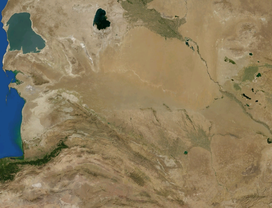Karakum Desert
| Karakum (Desert) | |
|---|---|
 Sand dunes in the Karakum Desert | |
 The Karakum Desert byNASA World Wind | |
| Area | 350,000 km2(140,000 sq mi) |
| Geography | |
| Country | Turkmenistan |
| State/Province | Central Asia |
| Coordinates | 40°30′N60°00′E/ 40.500°N 60.000°E |
TheKarakum Desert,also spelledKara-KumandGara-Gum(Turkmen:Garagum,pronounced[ɢɑɾɑˈɢʊm],fromgara( "black" ) andgum( "sand" ); Russian:Караку́мы,romanized:Karakumy,IPA:[kərɐˈkumɨ]), is adesertinCentral Asia.The name refers to the shale-rich sand beneath the surface.[1]It occupies about 70 percent, or roughly 350,000 km2(140,000 sq mi), ofTurkmenistan.
The population is sparse, with an average of one person per 6.5 km2(2.5 sq mi). Rainfall is also rare, ranging from 70 to 150 mm (3 to 6 in) per year.[2]
Geography
[edit]The desert covers roughly seventy percent ofTurkmenistan,[3]a long east–west swath. It sits east of theCaspian Seawhich has a steep east bank. It adjoins, to the north, the long delta feeding theSouth Aral Seafurther north, anotherendorheic lake,about 58 m (190 ft) higher than the Caspian Sea. The delta is that of theAmu Daryariver to the northeast, demarcating the long border with theKyzylkum DesertofUzbekistan.The desert is divided into three regions, the elevated northern Trans-Unguz Karakum, the low-lying Central Karakum, and the southeastern Karakum, home to a chain ofsalt marshes.[4]Since the early 1980s, the relatively small desert extension, theAralkum,has come to occupy most of the formerseabedof theAral Sea,about 15,440 sq mi (40,000 km2). The sea has fluctuated over millennia, but its majority loss during theSoviet Union's existence coincided with great irrigation projects. TheNorth Aral Seawas partly restored, but the South Aral Sea ebbed to a small-size stasis at its river mouth,[5]which itself dried up by 2014,[6]leaving only fragments of the former sea behind, such asBarsakelmes Lake.

Within the north-west edge of the desert used to be a river. In the latePleistocene,the Amu Darya used to flow beyond the Aral Basin toSarykamysh Lakethen to the Caspian Sea. Sedimentation and floods during a pluvial period led to overflow to theZeravshan Rivervalley to the east. The two flows merged and formed or expanded Horezm Lake, which had been formed by the earlier Khvalinian period, and as it overflowed northwards it carved its link with the Aral Sea along the Akcha Dar'ya population corridor of that low, gentle valley (a remote community of Western Uzbekistan and north-east Turkmenistan).[7]
Environment
[edit]The sands of the Aral Karakum are made of finely-dispersedevaporitesand remnants of alkaline mineral deposits, washed into the basin from irrigated fields.
Wildlife
[edit]Wildlifein this area is not very diverse and includes insects and arachnids such asants,termites,ticks,spiders,dung beetles,anddarkling beetles.Lizards,turtlesandsnakesalso live in the Karakum. Bird species includeAlauda,desert sparrows,and other species, while rodents includejerboasandgophers.Thetolai hare,goitered gazelle,andcorsac foxare examples ofmammal speciesin the Karakum Desert.[8]
Geology
[edit]
The Karakum is home to theDarvaza gas crater.Also called the "Door to Hell" or the "Gates of Hell" by locals, it is a crater of natural gas that has been burning since 1971. The crater is a major tourist attraction, with hundreds of visitors arriving each year.[9]
The area has significantoilandnatural gasdeposits.[citation needed]
Hydrography
[edit]To the south theMurghabandTejenrivers flow out of theHindu Kushmountains, flow west, and empty into the desert, providing water for irrigation.
The desert is crossed by the second-largest irrigation canal in the world, theKarakum Canal,which brings water from the Amu Darya to southern regions of the desert.[1]Construction on the canal was started in 1954 and completed in 1958.[1]It is 1,375 km (900 mi) in length, and carries 13 to 20 km3of water annually.[1]
Archaeology
[edit]Within the Karakum are theUly Balkan,a mountain range in which archaeologists have found human remains dating back to theStone Age.
Economy and resources
[edit]TheoasesofMaryandTejenare noted forcottongrowing.
Transport
[edit]The desert is crossed by theTrans-Caspian Railway.
Golden Age Lake
[edit]Golden Age Lake,known as Altyn Asyr köli locally,[10]alternatively as Karakum Lake, is a man-made lake under construction in theKarashor Depressionin the Karakum Desert.
Upon completion, the lake will span 2,000 square kilometres (770 sq mi) with a maximum depth of 70 metres (230 ft), and hold more than 130 cubic kilometers (4600 billion cubic feet) of water. Filling the lake could take 15 years and cost up to $4.5 billion.[11]According to government plans, it is intended to be filled by a 2,650-kilometer (1,650 mi) network of tributary canals. The Dashoguz Collector, spanning a distance of 432 kilometers, traces approximately half of its course along the historic path of theUzboy River.The Great Turkmen Collector starts inLebap Provinceand is 720 km (450 mi) long.[12]They are used for pumping run-off water from irrigated cotton fields[13]towards the lake.
See also
[edit]Notes and references
[edit]- Footnotes
- References
- ^abcdScheffel, Richard L.; Wernet, Susan J., eds. (1980).Natural Wonders of the World.United States of America: Reader's Digest Association, Inc. pp.199.ISBN0-89577-087-3.
- ^"Karakum Desert -- Britannica Online Encyclopedia".britannica.Retrieved2008-02-22.
- ^"Karakum Desert | Map & Facts | Britannica".britannica.Retrieved2022-01-28.
- ^"Karakum Desert | Map & Facts | Britannica".britannica.Retrieved2022-01-28.
- ^"Aral Sea".State of Environment of the Aral Sea Basin: Regional Report of the Central Asian States.International Fund on the Aral Sea. 2000. Archived fromthe originalon 16 March 2009.
- ^"World of Change: Shrinking Aral Sea".The Earth Observatory.National Aeronautics and Space Administration.Retrieved3 November2022.
- ^Razakov, RM (1996).The Aral Sea Basin.Springer.ISBN978-3-642-64736-9.Retrieved27 March2019.
- ^Rustamov, Anver K. (1994),"Ecology of Birds in the Karakum Desert",Biogeography and Ecology of Turkmenistan,Monographiae Biologicae, vol. 72, Dordrecht: Springer Netherlands, pp. 247–263,doi:10.1007/978-94-011-1116-4_15,ISBN978-94-010-4487-5,retrieved2021-07-31
- ^Geiling, Natasha."This Hellish Desert Pit Has Been On Fire for More Than 40 Years".Smithsonian.Retrieved2017-06-19.
- ^President inaugurates Turkmen lake
- ^Turkmenistan creates vast lake in the desert[dead link]
- ^A New Great Lake—or Dead Sea?
- ^Turkmenistan Vows to Water its Desert
External links
[edit]- Gonur Depe site in the Karakum Desert
- photos and about the Karakum Desert
- TravelBlog Darvasa Craters: Entrance to Hell
- Where Is the Karakum Desert? at WorldAtlas
- Kropotkin, Peter Alexeivitch;Bealby, John Thomas (1911)..Encyclopædia Britannica.Vol. 15 (11th ed.). pp. 675–676.
